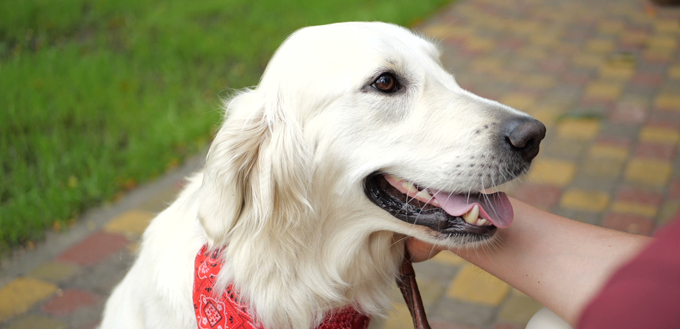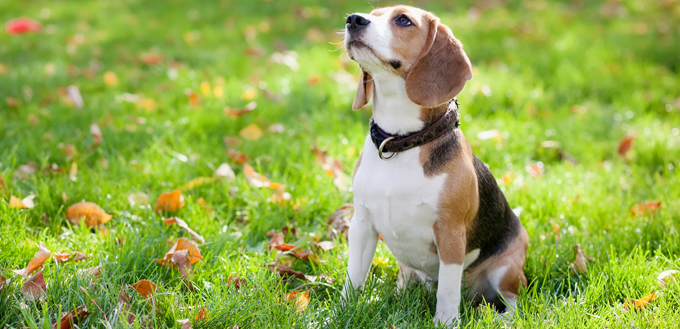We all have this fervent wish to be able to communicate verbally with our dogs. While there really is no way they can communicate with us in a way that we communicate with our friends and loved ones this does not mean they don’t have a means of conveying or expressing their intentions or even their emotional state. The point is, dogs do communicate, just not in the manner that we comprehend. Being gifted with a more complex intellect and profound understanding, it is thus up to us to learn and understand the body language of a dog to help us gain an insight to what they really are feeling, their intentions, and their needs.

The Eyes
Just as you can easily see if your best friend is happy or sad by simply looking at his or her eyes, a dog’s eyes can also give you an idea of what it is feeling. Puppies and dogs that have otherwise normally-shaped eyes can be understood as pooches that are happy and relaxed.
If the eyes are a bit larger than usual, this can mean quite a number of things. It may mean your pet is threatened by something, that is why it is trying to be as vigilant and alert as it can be. Aggressive dogs also tend to have eyes that are larger than the usual since they want to get as much of the ‘picture’ to fight another dog or another animal. It can also mean that your dog is feeling so stressed out. Remember that the natural reaction of the eyes to stress is the dilatation of the pupils which effectively increases the visual capacity of the eyes.
Now, if the eyes of your dog are smaller than normal, it can mean that it is not feeling well or is ill or is in pain. This is often taken together with the rest of the facial expression of your dog which is typically described as ‘sad’ or ‘depressed’. Smaller than usual eyes can also be seen on submissive dogs as well as those that are stressed out or frightened.
Your pooch’s gaze can also tell you something. A dog that is looking at you directly with a wide smile on its face essentially tells you that it is actually being friendly and it really hopes you’ll take notice of him. But if it looks at you directly as if gazing at you with a very stern look, you might as well back off as this dog is usually tense. Also, you might want to look away since this is what dogs normally do if they don’t want to look threatening to other dogs or even to humans.
If you look at a dog and it looks away or averts its gaze, it usually means that this dog is quite submissive. Or, it is also possible that it is worried or maybe even afraid of interacting with you especially if it has a history of being hurt by other people in the past. If the outward look of the dog is such that you see more of the white of its eyes, it usually is an indication of an impending aggressive outburst. You may have already seen this look from a dog that is chewing on a toy and you attempt to take the chew toy away from it. This is what experts call the whale eye. This is different from a pooch that is resting and giving you the same look; it’s too tired to lift its head so it just rolls up its eyes to meet yours.
The Mouth
The mouth of a canine can tell you a lot about its temperament and its general mood. For example, if a pooch is happy and relaxed, you can see its mouth to be slightly open, often pointing upwards at the corners as if smiling. If the dog’s mouth is closed, it typically indicates that it is frightened. Or, it is also possible that it is being submissive especially if it will somehow pull the corners of its mouth a little towards the back. It might even flick its tongue or lick you or another pet. Some dogs that are known to ‘yawn’ in an exaggerated manner are actually being uptight.
There’s one canine mouth behavior that is often misinterpreted by many folks as a sign of canine aggression. Known as the submissive grin, a dog will typically have its lips pulled vertically, displaying its front teeth. If this is the only sign that you observe, then perhaps the dog is posturing aggressively. However, if you also see lowered head, squinty eyes, whining, or even yelping, it is actually an indication of the dog being submissive. Do take note that not all dogs display the submissive grin so you really have to be careful when interacting with such.
A sign that a dog is quite aggressive is when it wrinkles the top of its muzzle and shows almost all of its teeth, not only the canines and the incisors. If you see this mouth behavior together with other signs of dog aggression, then it is simply telling you to back off and don’t attempt to go any closer. Another variation is when they wrinkle their foreheads while puffing and enlarging their lips in a behavior known as aggressive pucker. The same meaning applies – don’t go closer.
And then there are canine mouth behaviors that indicate fear. This is seen in dogs that have their lips drawn horizontally instead of vertically so that their lips are really tight at the corners. This facial mouth expression typically shows off a dog’s front and back teeth but not the middle teeth. Do be on the lookout, however, since these dogs can readily snap at any time.

The Ears
To understand the body language of dogs using based on the behavior of their ears, it is crucial to learn the ‘normal’ ear anatomy of your canine breed. Remember that different breeds have varying ear anatomies. A Basset hound’s ears typically hang long on the side of its head while that of a German shepherd will usually have it pricked. Still there are others that drop, similar to a Basset hound except that the pinnae are usually shorter like those of a Beagle. These are also semi-pricked ears like those from a Shetland sheepdog. The point is that the normal shape and orientation of the ear specific to your breed is crucial to understanding the behavior inherent in this canine body organ.
If your dog is happy and relaxed, you’ll see its ears to be in the normal position. If it is especially alert it will raise its ears straight up and point these in the direction where the ‘stimulus’ is coming from. If your pooch is feeling a bit aggressive it will raise its ears and tilt it slightly forwards. If the ears are pulled slightly backwards, there is a good chance that the dog is being friendly and it wants you to notice it. If the ears of your dog stick outwards from its head or is completely flattened against it, it is possible that your dog is feeling submissive or that it is truly frightened.
The Tail
There is this popular notion that a wagging tail is often an indication that a dog is friendly. Unfortunately, interpreting canine behavior based on the actions of its tail can be quite challenging since it can mean a lot. Do understand that, like a dog’s eyes and ears, it is crucial to know first what can be considered as a ‘normal’ tail for the kind of dog that you have.
A relaxed dog typically has its tail in its normal, natural position. A happy dog will wag it a bit, often from side to side. A really happy or excited pooch will wag its tail more forcefully. A submissive or nervous pooch typically tucks its tail between its hind legs or it may simply lower its tail. If it is just submissive or nervous, it may wag a bit. But if it is really scared, then you cannot expect any movement at all from its tail. A highly alert or vigilant pooch will typically hold its tail a bit higher than the usual stance, often without moving it. If the hound feels it needs to stand its ground, it raises its tail as stiff as possible and moves it quite rigidly in a back and forth motion.
The Hair
Yes, your dog’s hair can also tell you something about its ‘mood’ or whatever it is your pooch is thinking. An overly stressed out dog or a frightened pooch typically sheds a lot more than the usual. Don’t believe us? Try getting your nervous pooch to the vet and you’ll see tons of hair on the examination table once you scoop it up back home. A pooch raising its hackles can typically mean that it is afraid, wildly excited, angry, nervous, insecure, or even quite unsure. You will need to correlate this with other body language to get the right meaning.

Your Dog’s Body Posture
A relaxed and fully approachable dog typically has its head held high in the normal position, the ears are also in their normal position, and the mouth is slightly open with the tongue exposed. The stance is rather loose with its weight squarely planted on its feet. Its tail is also in its normal position.
An alert dog that seems like checking things out will often have its eyes wider than normal, its ears are tilted slightly forward, and its mouth closed. Its tail may also be raised almost parallel to the ground but is never stiff or bristled. It is even possible that its tail will move just slightly side to side. Its stance is a bit leaning forward and it can be seen as standing tall on its toes.
If you have a dominantly aggressive pooch, you can see quite a variety of behavior from its body. It may curl its lips, show its teeth and gums, wrinkle its forehead, raise its hackles, and even raise and bristle its tail. The tail may also be stiff and may actually look quivering. The legs are stiff and the body typically leans a bit forward.
If your dog is frightened but not submissive, you can expect the following observations. Ears are pulled back, its pupils are dilated, nose is wrinkled, and its hackles are raised. The body will be lowered especially at the front and its tail is tucked in between its hind legs, typically with minimal to no movement. The lips are also slightly curled.
A stressed or distressed dog will typically have its pupils dilated, ears pulled back, tail down, and body lowered. However, the most important behavior you need to look for is the rapid panting usually through the corner of its mouth. You might even see perspiration from its paw pads.
A dog that is worried or even fearful will have some of the body language of a stressed pooch. However, it will typically make very brief or indirect eye contact, its forehead is smooth, it front paw is raised, and may lick another dog or another person. Its tail, while completely down, may wag a bit.
If your pooch rolls onto its back, exposing its tummy and throat, this is usually an indication of total submission. Or, it can also mean extreme fear. Its ears are flattened and moved towards the back, its eyes are partly closed, and its tail is tucked. It may even drip urine.
A dog that has its front legs lowered and bent at the forepaws while sticking its behind up and out will often indicate a dog that is in a playful mood. Its ears are also up, its pupils are wide open, and its tail may wave in a more frenzied pace. Its mouth is also open, typically exposing its tongue. Understand that the dog in a playful mood will typically not sustain this stance because sooner or later it will break into something entirely different as if enticing you to play with it.
Learning dog body language is the key to bridging the communication gap. Starting with an understanding of what a ‘normal’ dog looks like, you can then determine if a dog is happy, relaxed, aggressive, fearful, submissive, stressed, or playful. Canine communication is a learning curve for the dog and its human. We just have to put our time and effort in learning it to deepen our understanding.
Sources:
- 7 Tips on Canine Body Language, American Society for the Prevention of Cruelty to Animals
- Dog Body Language, Best Friends Animal Society
- What’s Your Dog’s Body Language Saying?, Animal Humane Society
- How To Read Dog Body Language, American Veterinary Medical Association







